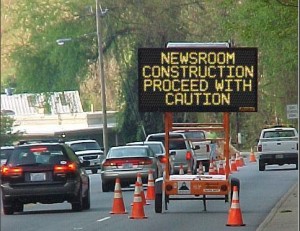Welcome to the digital future, Digital First and San Francisco Chronicle
In the last few days, the tide seems have turned in America’s newspaper newsrooms. The San Francisco Chronicle’s managing editor, Audrey Cooper, talked in detail about the paper’s plans to revamp its focus:
“You look around this newsroom and it looks like it did in that photo in 1958,” she said. “The only thing that has changed is that now we have some women. It’s great we have the history and the dust and stuff that makes newsrooms such eclectic places but it’s very difficult to change your behavior if you’re still in the place that was publishing a newspaper in 1958.”
In addition, she said, “It’s important to get the staff away from me saying, ‘What do you have for Page 1?’”
Digital First Media revealed Project Unbolt, a sweeping plan to push the print newspaper into second place:
“Since newsrooms began publishing online the digital operations have been bolted on to the legacy print workflow and structure. While Digital First Media’s newsrooms have made great strides, we must accelerate our digital transformation,” said John Paton, Chief Executive Officer of Digital First Media. “Project Unbolt is about reimagining every aspect of the newsgathering and publishing process. Despite the continued existence of print, our workflow and our technology are digital only, not just Digital First.”
I think I’ve heard these songs before. Heck, I’ve sung these digital-future songs before. Making newsrooms focus on digital journalism is the core of the much-maligned changes that Advance Digital has been enacting over the last few years. If you’re not familiar with Advance Digital’s push, you might want to read one of the earliest posts on this blog:
Up to now, you have been print journalists, gradually adding online elements. Our news meeting times, our deadlines (indeed, the very existence of deadlines), our decisions about how stories are structured, all of those and more have been based on what works for print. We write “Sunday stories,” because Sunday is the biggest circulation day. Those stories are finished most often on Fridays, because that gets them done in time to be placed in the Sunday paper. We select one photo for a story because that’s all we’ll have room for in print.
Rather abruptly, you’ll all become digital journalists. You and your supervisors will focus on the online readers.
Welcome to my world, Digital First and SF Chronicle. It won’t be easy, and it won’t be comfortable. As I wrote last year, “We have to get used to working in an environment where things keep changing. And that means everything.” The habits of print production are deeply ingrained in most newsrooms; they have become entangled with our views of what makes journalism ethical, interesting and important. You won’t only have to change those attitudes; you’ll also have to get used to no longer standing on the solid ground created by decades of doing things the same way. You will learn about search-engine optimization, only to be told months later that you need to focus more on social media. You’ll adjust to guidelines for getting noticed on Facebook, only to wake up to a completely new set of guidelines from Zuckerberg & Co. You’ll find a new openness to experimentation — but that’s accompanied by much faster, more ruthless ways to gauge whether those experiments are working. You will stumble, and some readers will howl as if you’ve never stumbled before. You will be surprised at how quickly some veteran journalists adapt, and shocked at how unprepared some younger ones are.
Where you are going, I have been. Now that the lessons I learned working for Advance Digital’s Plain Dealer don’t seem as out-of-the-mainstream, maybe you’d like to know what I know. Watch this space.

